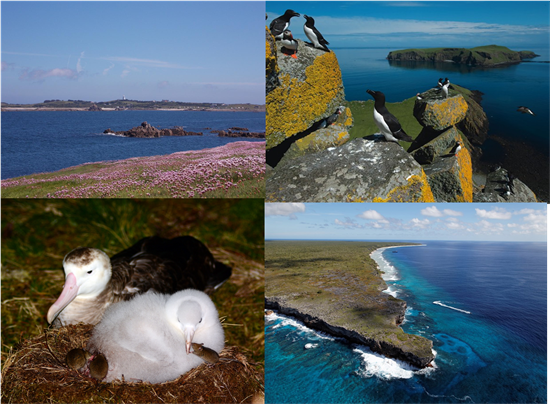March 2017
The RSPB has a long history of engagement with invasive species matters, contributing to the development of government and organisational policies intended to tackle the issue, and promoting best practice on our own nature reserves and across all of our work. We are also members of Link’s Invasive Non-Native Species Working Group, which gives us the opportunity to work with other environmental organisations to develop effective ways of managing invasive species.
Invasive species’ impacts are particularly severe on islands. As RSPB reserves include some of the most important and well-known seabird colonies in the UK, we are working to position ourselves as one of the international leaders in seabird island management and restoration. By protecting these sites against future invasions we will maintain safe breeding grounds for native species, maximising their breeding productivity and their resilience against other challenges, in particular climate change.


Montage of seabird recovery projects (clockwise front top left: St Agnes and Gugh, Shiants, Henderson Island, mice eating albatross chicks on Gough).
© Ed Marshall www.rspb-images.com
As a general rule, once a non-native species has established somewhere new it can be difficult and costly to remove it. However sometimes there is a clear conservation imperative to do so. Such work can be dramatically successful, such as on offshore islands where introduced mammals such as rats and house mice prey on seabird eggs, chicks and adult birds. Having evolved in isolation from mammal predators, often these seabirds have few defences against them. The RSPB has developed best practice guidance for advancing this island restoration work, and worked with partners to undertake invasive species eradication projects on seabird islands including the Scillies, Lundy, and the Shiants. Plans for major new projects on Gough Island and the Turks and Caicos Islands, UK Overseas Territories in the Atlantic, are well under way, with the latter project launching next week.
Each of these projects are major undertakings, and the job is not complete once the initial eradication has taken place: an invasive mammal eradication on an island cannot officially be declared a success until two years after the last sign of the target species is detected. For example, following an intensive programme of baiting and poisoning to remove brown rats from St Agnes and Gugh in the Isles of Scilly over the winter of 2013-14, last year the islands were officially declared rat-free. Rats are thought to have first colonised the islands in the 18th century following several shipwrecks. As a result the breeding seabird population declined by nearly a quarter in 25 years, including declines in globally important populations of European storm-petrel and Manx shearwater. This was the largest rodent eradication project on inhabited islands to date, and saw the RSPB working with four project partners, and a large number of island residents who volunteered to help. The success of the project has been reflected in the news that both Manx shearwater and European storm-petrel have since been recorded successfully fledging chicks from the islands.
In addition to the practical aspect of invasive species action, RSPB works to develop and advocate policy approaches to tackling invasive species issues at national, EU, and international levels. This is why we support the IUCN's Honolulu Challenge on Invasive Non Native Species. We were recently active in the development of a new EU regulation on invasive species which entered into force in 2015. Before this, action to combat invasive species had been inconsistent and patchy across member states, whereas this new regulation aims to being everyone up to the same minimum standard. As a result, 37 invasive species are now banned from sale, breeding, transport, captivity or release across the EU, and the European Commission has committed to updating this list regularly. In the context of the UK’s exit from the European Union, RSPB will be working with our Link partners to ensure that future UK invasive species legislation continues to apply at the very least equivalent, and ideally stricter, control of species movements and release.
Martin Harper
Conservation Director, RSPB
Find Martin on Twitter: @martinRSPB
Aspects of this blog appeared on the RSPB website. The opinions expressed are the author’s and not necessarily those of the wider Link membership.




Latest Blog Posts